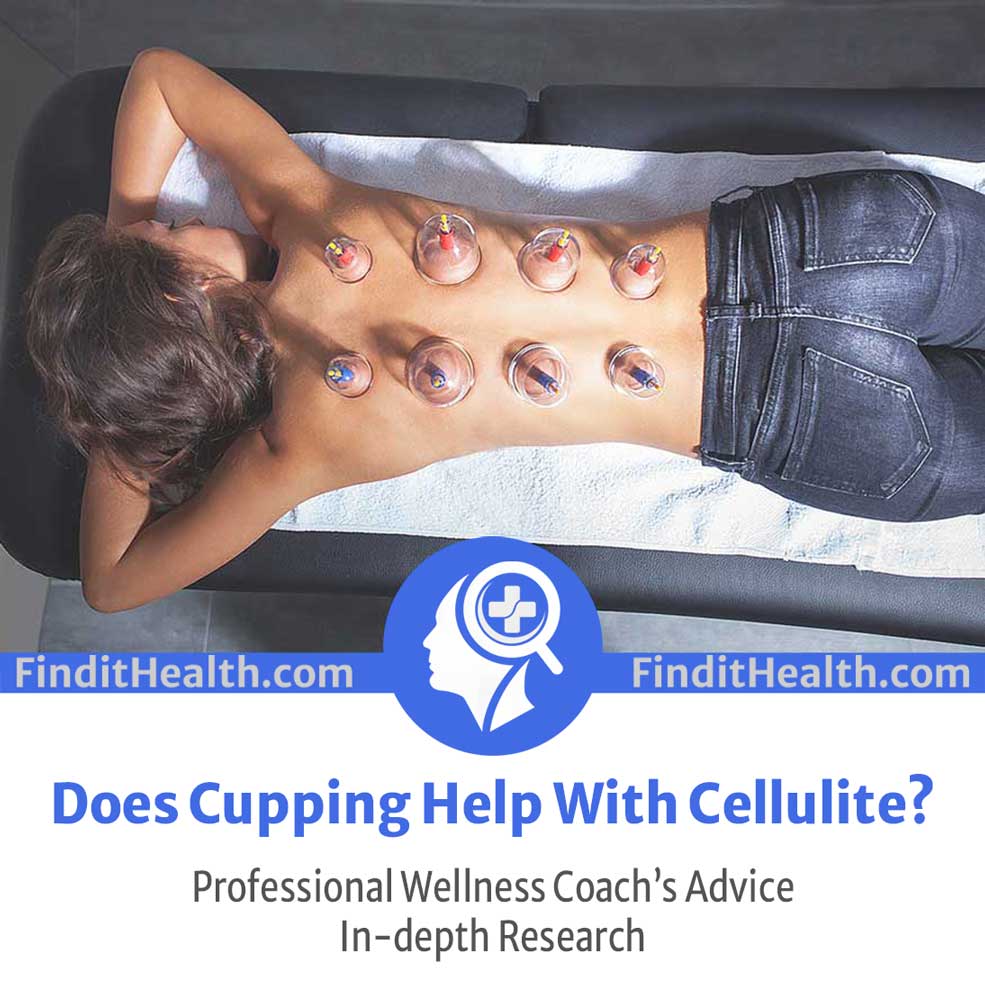
I’m here to discuss the advantages of cupping on cellulite in my capacity as Findhealth.com’s main health and wellness counselor.
Cupping is a popular alternative therapy with established efficacy on many health conditions including improving the appearance of the skin. Cupping functions by stimulating blood flow and encouraging the flushing out of toxins from the body. This article can serve as your introduction if you’re thinking about using cupping to treat stubborn cellulite. Please read on to find out more!
Cupping For Cellulite
In order to improve poor blood circulation, lymphatic drainage, and the breakdown of fatty deposits that contribute to the appearance of cellulite, cupping for cellulite therapy uses suction cups to create a vacuum effect on the skin.
According to the theory, the suctioning motion breaks up and dislodges the trapped fat under the skin.
By removing the cellulite-related dimpling and smoothing the skin, this may help improve the look of cellulite.
The negative pressure produced by cupping causes a draining of stored fluids, toxins, and other chemical substances, especially the lipids that contribute to cellulite.
SUBSCRIBE for FREE STRESS MANAGEMENT TECHNIQUES from our EXPERT COACHES!
Pros And Cons Of Cupping For Cellulite
The following are some possible benefits and drawbacks of utilizing cupping for cellulite.
Pros
- Improved blood flow: Cupping therapy is believed to help improve blood circulation, which can help to reduce inflammation and swelling and promote healing.
- Reduced appearance of cellulite: Some people report seeing improvements in the appearance of cellulite after undergoing cupping therapy. This may be due to the increased blood flow and lymphatic drainage that occurs as a result of the suction cups.
- Non-invasive: Cupping is a non-invasive therapy that does not involve any incisions or injections, which may make it a more appealing option for those who want to avoid surgical procedures or other invasive treatments.
Cons
- Limited scientific evidence: While many people report positive results from cupping therapy for cellulite, there is limited scientific evidence to support its effectiveness for this condition.
- Potential side effects: Cupping can cause side effects such as bruising, soreness, and skin irritation. While these side effects are generally mild and temporary, they can be uncomfortable or unsightly for some individuals.
- Need for ongoing treatment: To see lasting results from cupping therapy, it may be necessary to undergo regular sessions over some time. This can be time-consuming and may be costly for some individuals.
SUBSCRIBE for FREE STRESS MANAGEMENT TECHNIQUES from our EXPERT COACHES!

How Can Cupping Help Cellulite?
The lipid-filled fat that creates the dimpled appearance of cellulite is drawn to the skin’s surface by cupping. Cupping also encourages circulation in this way.
From the perspective of traditional Chinese medicine, cellulite is no different from a condition brought on by energy flow stagnation or obstruction. By boosting circulation and minimizing fluid buildup, cupping relieves these obstructions. Even better, specific body parts, such as the thighs and buttocks, can be cupped.
SUBSCRIBE for FREE STRESS MANAGEMENT TECHNIQUES from our EXPERT COACHES!
Does Cupping Completely Get Rid Of Cellulite?
There is evidence from research that in some, but not all, situations, cupping may temporarily smoothen out cellulite.
Cupping must be used in conjunction with a good diet, regular exercise, and other cellulite treatments like massage and dry brushing for the best results.
Keep in mind that cellulite occurs naturally and frequently in many people.
Cellulite is not a disease that needs to be cured. It is a cosmetic concern that many people want to be treated for personal reasons.
Side Effects Of Cupping For Cellulite
Cupping therapy for cellulite can cause some side effects, including:
- Bruising: Cupping can cause bruising, particularly in areas where cellulite is present. The bruises may take a few days to fade.
- Soreness: The suction of the cups can cause soreness in the treated area. This may feel like a deep-tissue massage.
- Skin irritation: Cupping can cause temporary skin irritation, including redness, swelling, and itchiness.
- Dizziness: Some people may experience dizziness or lightheadedness during or after cupping therapy.
- Infection: There is a small risk of infection if the cups are not properly sterilized or if the skin is broken during the treatment.
- Worsening skin problems: Cupping can make a skin condition like eczema or psoriasis worse.Consult with a dermatologist before cupping therapy.
- Infection: Cupping can cause minor bleeding. An improperly sterilized equipment could spread dangerous blood-borne diseases such as hepatitis B and hepatitis C.
If you’re considering cupping therapy for cellulite, please let your doctor know, especially if you have a medical condition or are taking medicine that impairs your blood clotting or immune system.
SUBSCRIBE for FREE STRESS MANAGEMENT TECHNIQUES from our EXPERT COACHES!
Cupping For Cellulite: How Many Session Times A Week?
The optimal schedule for vacuum cupping for cellulite is three times per week. The objective is to gradually increase your daily session length to ten minutes.
Overall, the cupping therapy sessions and the length of those sessions can vary depending on the individual and the severity and breadth of the cellulite.
Frequently Asked Questions
Does cupping really work for cellulite?
Studies that looked at how cupping therapy affected the skin and subcutaneous tissue came to the following conclusions:
- In 2015, a small pilot study investigated dry moving cupping for cellulite. The research involved 40 healthy female participants. The thickness of cellulite was reduced by the cupping therapy, which was performed ten times on each thigh for five straight weeks.
- One study published in the Journal of Acupuncture and Meridian Studies in 2015 found that cupping therapy combined with other therapies such as acupuncture and massage was effective in reducing thigh circumference and improving skin elasticity in women with thigh cellulite.
- Another study published in the Journal of Cosmetic Dermatology in 2017 found that cupping therapy improved skin texture and firmness, and reduced the appearance of skin dimpling in women with cellulite on their thighs and buttocks.
Why does cupping for cellulite hurt?
During cupping, the skin and subcutaneous tissue are subjected to suction, which causes some slight pain or discomfort. Depending on the patient’s tolerance and sensitivity, the practitioner will modify the suction’s intensity.
Red blood cells are drawn to the area of the cup by suction, which can result in bruising that resembles an injury. However, these bruise marks are only superficial and frequently go away in a few weeks.
Can cupping make cellulite worse?
Although there is no evidence to suggest that cupping can make cellulite worse, the duration and intensity of the treatment could affect the severity of the bruising and soreness that follows after treatment.
How long does it take cupping to work on cellulite?
To notice a visible smoothening of the cellulite, it typically takes several weeks or months of consistent cupping therapy sessions paired with other healthy habits like a balanced diet and exercise.
It should be emphasized that while cupping therapy may help lessen the appearance of cellulite, it does not fully remove it.
What are the best natural treatments for cellulite?
Here are some natural treatments that may help reduce the appearance of cellulite:
- Dry brushing: It may be possible to lessen the appearance of cellulite by stimulating blood flow and lymphatic drainage by massaging the skin with a dry brush.
- Exercise: Regular exercise can help tone the muscles and increase circulation, which may help lessen cellulite. Examples of such workouts include cardio and strength training.
- Healthy diet: Consuming a well-rounded diet full of fresh produce, lean proteins, and healthy fats may encourage clear skin and diminish cellulite.
- Hydration: Water consumption can increase skin elasticity and aid in the removal of toxins from the body, which could improve cellulite.
- Massage: Regular massage is beneficial for cellulite and can enhance lymphatic drainage and blood flow.
- Coffee scrubs: Applying a coffee scrub to the skin can enhance blood flow and lessen inflammation, which could help minimize cellulite.
What kind of massage breaks up cellulite?
A 2010 study looked into the effects of three types of massages on cellulite namely mechanical massage, lymphatic drainage massage, and connective tissue manipulation (CTM) massage. All three techniques were found to be effective in decreasing fat and thigh circumference where the massage was performed.
Can cellulite be massaged away?
Cellulite can’t be cured by massage. Although repeated massage sessions are required, massage may help reduce the appearance of cellulite. Cellulite is reduced with massage by:
- Draining excess body fluids
- Spreading the fat cells around
- Increasing blood flow
- Boosting skin elasticity
SUBSCRIBE for FREE STRESS MANAGEMENT TECHNIQUES from our EXPERT COACHES!
Conclusion
Compared to other cellulite treatments, such as surgery or laser therapy, cupping is generally less expensive and does not require any downtime. Additionally, cupping can be performed on various parts of the body, including the legs, thighs, and buttocks, which are common areas for cellulite.
However, it is important to note that cupping may not be suitable for everyone and it is always recommended to consult with a healthcare professional before trying any new treatment. It is also important to have realistic expectations and understand that while cupping may help improve the appearance of cellulite, it may not completely eliminate it.
SUBSCRIBE for FREE STRESS MANAGEMENT TECHNIQUES from our EXPERT COACHES!

